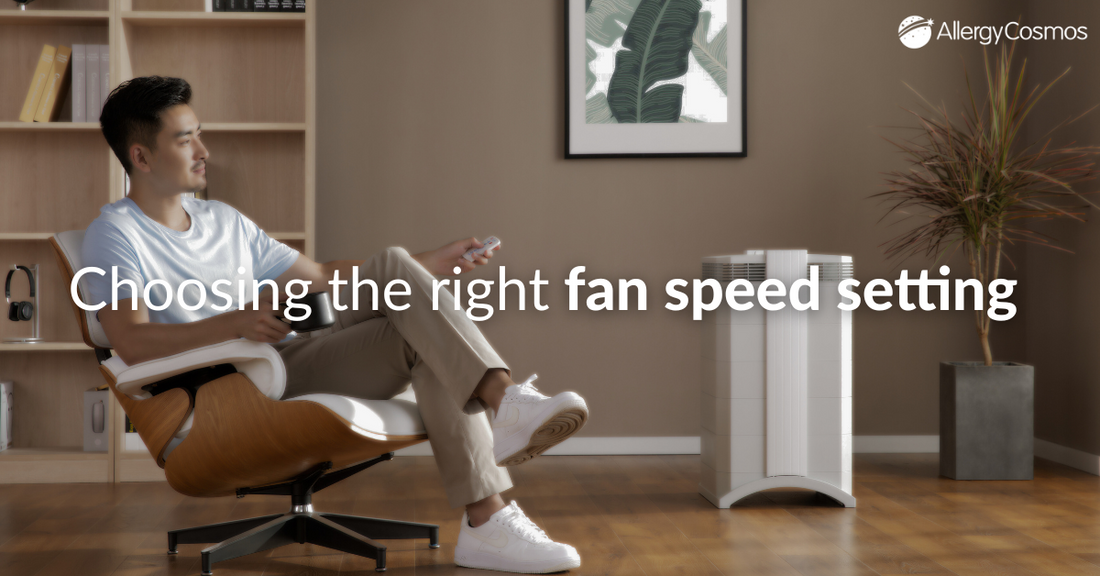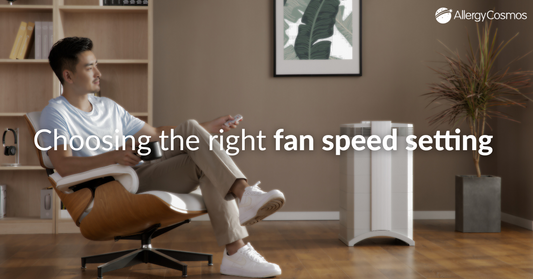An air purifier can be a very helpful device in most homes - and especially those where people suffer from allergies, asthma, COPD or simply want to protect themselves from viruses, bacteria, traffic soot, mould or tobacco smoke. An effective air purifier circulates and filters the air in a room, trapping contamination in its filters. It limits your exposure to airborne contamination and thus makes the air you breathe cleaner and healthier. There are several aspects to consider, however, for an air purifier to be effective. In this article, we will discuss how to get the best performance by choosing the right fan speed setting for your air purifier.
The first thing to consider when choosing the fan speed setting of your air purifier is the number of air changes the unit will achieve on a given speed setting. This will depend on the clean air rate (i.e. the amount of clean air) your air purifier can produce, and the size of the room you want to purify. If the room is small, and your air purifier is a mid to regular-size domestic air purifier, a low or medium fan speed may be sufficient. For example: if your room is 3 x 3 meters with a 3-meter ceiling height (i.e. 27 m3), and your air purifier produces 100 m3/h on a low to medium setting, your air purifier will clean the amount of air in the room 3.7 times an hour. However, if the room is larger, the same air purifier will need to run on a higher fan speed setting to achieve the same air change rate. If the room is 3 x 5 metres, for example, with a 3-metre ceiling height, and you still want to achieve 3 air changes per hour, you will want to run the unit on a fan speed setting that produces 135 m3/h or more (i.e. 3 x 5 x 3 x 3 =135).

Next, you should consider the level of contamination of airborne pollutants in the room you want to purify. High levels of contamination will require more air changes - and thus the use of a higher fan speed setting - to achieve a significant reduction of airborne contamination. The number of air changes that is appropriate for the level of contamination and the desired reduction of pollution will not only depend on the fan speed setting you run the unit on, but also the filtration efficiency of your air purifier. An air purifier with a poor whole system filtration efficiency of 50% for example, will have to achieve more air changes than an air purifier with a near perfect filtration efficiency, such as the IQAir HealthPro series.
Any air purifier should have a good range of different fan speeds for you to choose from, so that one unit can be used for a variety of different room sizes, usages and contamination levels. The noise level generated on the fan speed setting you choose is another essential aspect to consider when setting the fan speed of your air purifier. While a higher fan speed will purify the air in the room faster, it will also be noisier. If you plan to use your air purifier in a bedroom or any other noise sensitive area, check what the highest level is that you can run the unit on without it being disruptive. Then see how many cubic meters of clean air is being produced at that speed setting. Once you compare that to the size of the room, you will know how many air changes will be achieved, and if your air purifier can effectively purify the area you want to clean.
In summary, choosing the right fan speed settings for your air purifier is essential to ensure that you achieve the level clean air you want to achieve. Factors to consider include the size of the room, the actual filtration efficiency of the unit, the type and number of pollutants in the room, and the noise level that the air purifier will produce and that will be acceptable. By taking the time to choose the right fan speed settings, you can make the most of your air purifier and breathe cleaner, healthier air in your home.
If you have any questions, please do feel free to contact us anytime at: 0203 176 0713. Here are also some FAQ in regard to choosing the right fan speed for your air purifier:

1) Why use cubic metres when choosing a fan speed on an air purifier?
When choosing a fan speed on an air purifier, we use cubic meters (m3) to determine a) the overall size of the room and b) the m3 of clean air that the air purifier is producing/can circulate and purify in one hour. Using cubic meters allows you to compare the capacity of different air purifiers more easily, making it easier to find a model that might be suitable for the size of the room you want to clean.
2) What are ‘Clean Air Changes Per Hour’, and why are they important? How do I work out how many I can get?
“Clean Air Changes Per Hour” (ACH) is one of several metrics used to measure the efficiency of an air purifier. It represents the amount of clean air the air purifier produces in one hour. For example, if an air purifier has a Clean Air Changes Per Hour (ACH) rating of 2, it means that the device is said to purify an amount of air twice as large as the amount of air in the given room. The higher the ACH rating, the more air the air purifier moves. However, here it is important to point out that ACH is meaningless if you do not also consider the design of the unit as well as the unit’s actual whole system filtration efficiency.
Some air purifiers are poorly designed and the system has too much recirculation - i.e. the air outlet is too close to the air inlet. The filtration efficiency of an air purifier is equally important because an air purifier with poor filtration efficiency is just a fan - you will simply end up moving dirty air around.
4) Should the windows be closed while using an air purifier?
Whether the windows should be closed or opened to improve the effectiveness of your air purifier depends on where the source of contamination is coming from. If contamination is produced in the room (such as a person smoking, viruses or bacteria, indoor mould, dust mite allergens, pet dander or building work etc), ventilating will help to further dilute indoor airborne contamination. If the source of contamination is coming from outside (such as traffic pollution, pollen, building dust or wood burning etc), it will be easier to protect your indoor environment by keeping windows closed.
However, any indoor environment also has to be ventilated to ensure adequate levels of oxygen. Keeping the windows closed can also increase humidity levels, which can lead to mould growth. If you generally want to keep windows closed, it is recommended to ventilate through other means, such as using an extract fan or by opening a window for short periods of time throughout the day to allow fresh air to come in.




